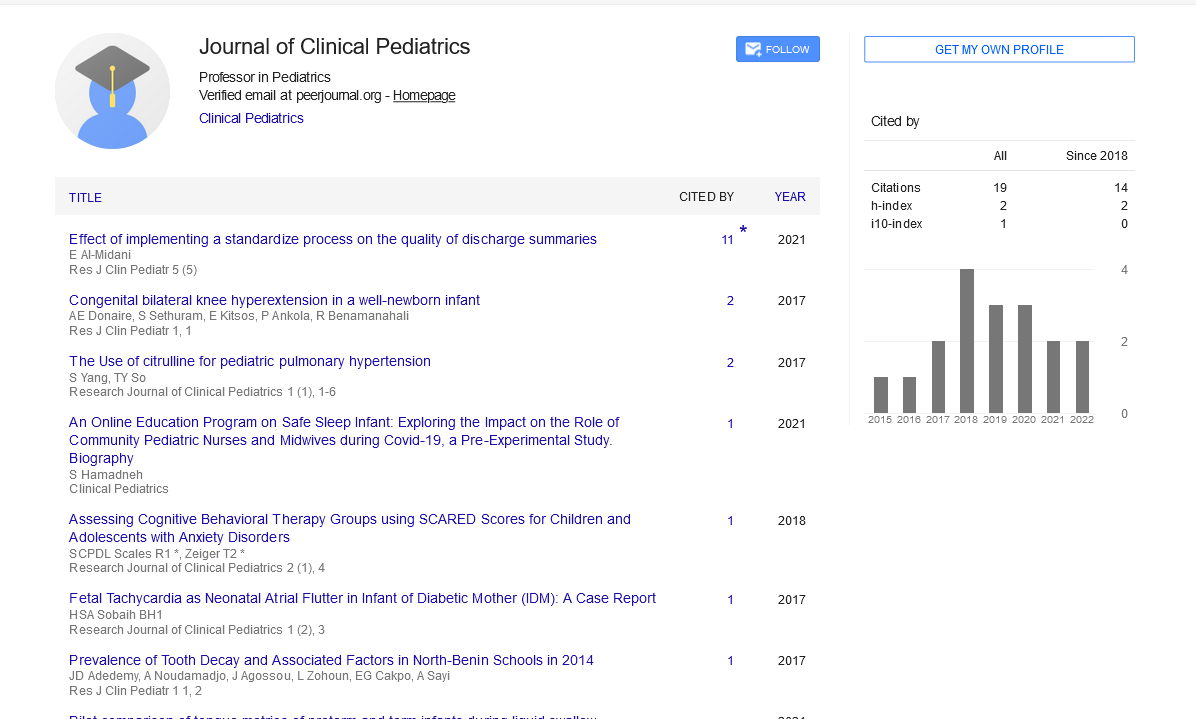Commentary, Res J Clin Pediatr Vol: 7 Issue: 3
Pediatric Dermatology: Clinical Approaches to Diagnosis and Therapy
Laura Juan*
1Department of Dermatology, State University of New York Downstate Health Sciences, Brooklyn, United States of America
*Corresponding Author: Laura Juan,
Department of Dermatology, State
University of New York Downstate Health Sciences, Brooklyn, United States of
America
E-mail: laura_juanund22@gmail.com
Received date: 23 August, 2023, Manuscript No. RJCP-23-117485;
Editor assigned date: 25 August, 2023, PreQC No. RJCP-23-117485 (PQ);
Reviewed date: 08 September, 2023, QC No. RJCP-23-117485;
Revised date: 15 September, 2023, Manuscript No. RJCP-23-117485 (R);
Published date: 22 September, 2023, DOI: 10.4172/Rjcp.1000152
Citation: Juan L (2023) Pediatric Dermatology: Clinical Approaches to Diagnosis and Therapy. Res J Clin Pediatr 7:3.
Keywords: Pediatric dermatology, Ultraviolet (UV), Dermoscopy, Allergies
Description
Pediatric dermatology is a specialized field within the realm of dermatology that focuses on diagnosing and treating skin conditions in children. The fragile and rapidly changing nature of pediatric skin necessitates a unique approach to diagnosis and therapy. One of the fundamental principles of pediatric dermatology is understanding the age-specific characteristics of a child's skin. From birth to adolescence, a child's skin undergoes various changes, and what might be considered a common skin condition in adults can present differently in children. For instance, eczema often manifests as red, itchy patches, but in infants, it may appear as oozing, crusted lesions. Pediatric dermatologists are skilled at recognising these age-specific variations and adjusting their diagnostic and therapeutic approaches accordingly.
Obtaining a comprehensive medical history is an essential step in diagnosing and treating pediatric dermatological conditions. Pediatric dermatologists carefully review the child's medical history, including family history, any recent illnesses, medications, allergies, and lifestyle factors. This information provides valuable insights into the potential triggers and causes of the skin condition, allowing for a more accurate diagnosis.
Visual examination is a vital component of pediatric dermatology. Skilled dermatologists carefully inspect the child's skin, hair, and nails to identify any abnormalities. They consider factors such as the location, size, colour, and texture of skin lesions. The visual examination often provides essential information for diagnosis, enabling the dermatologist to differentiate between common conditions like warts, moles, and more complex skin disorders.
Dermoscopy is a non-invasive diagnostic tool that is particularly useful in pediatric dermatology. It involves using a dermatoscope, which is a magnifying device with polarised light, to examine skin lesions in detail. This technique helps specialists assess the morphology and pigment patterns of skin lesions, aiding in the diagnosis of conditions like nevi, melanoma, and hemangiomas. In some cases, when the diagnosis remains uncertain, a biopsy may be recommended. Pediatric dermatologists use a minimally invasive procedure to extract a small sample of tissue for microscopic examination. Biopsies can confirm a diagnosis and determine the best course of treatment, especially for complex or rare skin conditions.
Allergies are common triggers for pediatric skin conditions such as eczema and contact dermatitis. Pediatric dermatologists may conduct patch testing or allergy blood tests to identify specific allergens responsible for a child's skin condition. Once the allergen is identified, the dermatologist can guide parents and caregivers on allergen avoidance and immunotherapy if needed.
Pediatric dermatology often emphasizes non-invasive therapies, especially for common skin conditions. Topical treatments like emollients, corticosteroids, and calcineurin inhibitors are frequently used to manage conditions such as eczema. Pediatric dermatologists ensure that these treatments are safe and effective for children and educate parents on their proper use.
For some pediatric dermatological conditions, such as psoriasis or vitiligo, phototherapy may be recommended. This treatment involves controlled exposure to Ultraviolet (UV) light under the supervision of a pediatric dermatologist. The therapy can help manage symptoms and improve the child's quality of life.
In cases of skin conditions that require surgical intervention, such as the removal of cysts, hemangiomas, or congenital nevi, pediatric dermatologists are highly skilled in performing minimally invasive or more extensive procedures. They prioritise techniques that minimize scarring and ensure the best possible cosmetic outcomes for their young patients.
Conclusion
Pediatric dermatology is a specialised field that requires a deep understanding of the unique characteristics of children's skin and the ability to diagnose and treat a wide range of dermatological conditions. Through age-appropriate evaluations, comprehensive medical histories, visual examinations, advanced techniques like dermoscopy, and a holistic approach, pediatric dermatologists ensure that children receive the best care possible. By combining diagnostic precision and gentle therapies, they make a significant impact on the lives of young patients, helping them achieve healthier, happier skin.
 Spanish
Spanish  Chinese
Chinese  Russian
Russian  German
German  French
French  Japanese
Japanese  Portuguese
Portuguese  Hindi
Hindi 
